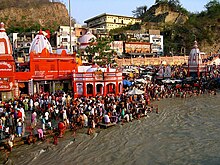Chapter 8: The Geography of Religion
8.4.4 Hinduism
Religion and Diffusion
Hinduism is a religious tradition that originated in the Indian subcontinent (Figure 8.4.4.1). Its origins can be traced to the ancient Vedic civilization (1500 BCE), a product of the invasion of Indo-European peoples. A conglomerate of diverse beliefs and traditions that assembled organically over centuries, Hinduism has no single founder.
There are three major beliefs in Hinduism:
- Reincarnation – Hindus believe all living things have a soul and when a living thing dies the soul is reborn into a new living thing.
- Karma – Good deeds and actions during one’s lifetime are rewarded with the soul moving to a higher-ranking creature. Similarly, bad deeds and actions are punished with the soul moving to a lesser creature. And
- Dharma – a set of rules that differ for each living thing that must be followed to move up the ladder in reincarnation. The final step in reincarnation (moksha) is perfection and reuniting with their supreme god, Brahman.
Due to its concurrent growth with Indian civilization, Hinduism has historically been tightly bound to the caste system, although the modern Indian state has worked to ameliorate the more damaging effects of this relationship.

Source: “Figure 6.7 Hindu Places” in “Introduction to Human Geography” by David Dorrell via LOUIS Pressbooks is licensed under CC BY-SA 4.0.
For a good map showing Hinduism as a percentage of country population please click here.
Hinduism is the third-largest religion worldwide, with approximately 1.2 billion Hindus in many countries. Interestingly, however, Hinduism is the dominant religion in only three countries, India with 79%, Nepal with 80%, and Mauritius with 48%.
Although Hinduism is rarely a country’s primary religion, it still enjoys a global presence. Many regions around the world support significant populations of Hindus, including the Caribbean, Southeast Asia, North America, and South America.
Appearance in the Cultural Landscape

Source: “Simhachalam-temple-2 big” by Sureshiras via Wikimedia Commons is licensed under CC BY-SA 3.0.
Simhachalam TempleHinduism appears in the cultural landscape through various distinctive elements that reflect its deep cultural and religious significance. Foremost, there are temples and shrines. Hindu temples, often intricately designed and elaborately decorated, are prominent features. They vary in architectural styles, such as Dravidian in the south and Nagara in the north, and often include towering spires, ornate carvings, and statues of deities.

Source: “Ganga Dashara, at Haridwar” by gbSk via Wikimedia Commons is licensed under CC BY 2.0.
Sacred sites such as certain rivers like the Ganges, mountains like the Himalayas, and forests may be considered sacred and /or hold significant religious importance. Pilgrimage sites such as Varanasi and Rishikesh attract many visitors; the latter, situated on the holy Ganges River, is renowned as a center for studying yoga and meditation.Temples and ashrams (centers for spiritual studies) line the eastern bank. Another location, Puri, also a significant pilgrimage site in Hinduism, is renowned for the Jagannath Temple, where the annual RathYatra festival attracts millions of devotees. It is considered one of the four Char Dham pilgrimage sites, believed to be essential for attaining spiritual salvation.
Hindu festivals, such as Diwali, Holi, Navaratri, and Kumbh Mela, shape the cultural calendar and have significant social and economic impacts. These events often involve large gatherings, processions, and rituals, influencing local infrastructure and community life.

Source: “6th century Ganesha Badami Caves” by Ms Sarah Welch via Wikimedia Commons is licensed under CC0 1.0.
Many homes have small shrines or altars dedicated to family deities. In villages, communal spaces often include temples or sacred trees where community rituals and festivals are held. Public and private spaces frequently display statues and images of Hindu deities, like Shiva, Vishnu, Lakshmi, Ganesha and Hanuman. These icons are often placed at crossroads, in marketplaces, and at entrances to villages and cities.

